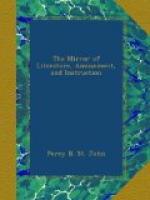About the beginning of this century, an ingenious individual belonging to the village of Cumnock, in Ayrshire, of the name of Crawford, having seen one of the Laurencekirk snuff-boxes, succeeded, after various attempts, by the assistance of a watchmaker of the same village, who made the tools, in producing a similar box; and by his success, not only laid the foundation of his own fortune, but greatly enriched his native parish and province. For awhile, the Laurencekirk boxes were most in demand; but Mr. Crawford and his neighbours in Cumnock not only copied the art, but so improved and perfected it, that in a very few years, for every box made in the north there were, probably, twenty made in the south. In 1826, the Cumnock trade was divided amongst eight master manufacturers, who employed considerably more than 100 persons. The demand at that time equalled the supply, and it was calculated that the trade yielded from 7,000_l._ to 8,000_l._ annually,—a large product for a manufacture seemingly so insignificant, and consisting almost exclusively of the wages of labour. Plane is the wood in common use, and the cost of the wood in an ordinary sized box does not exceed 1d.; the paints and varnish are rated at 2d.; and though something is lost by selecting timber of the finest colour, the whole expense of the raw material falls considerably short of 1/2 per cent. on the return it yields!
Snuff-box, like pin making, admits of subdivision of labour; and in all workshops of any size three classes of persons are employed—painters, polishers, and joiners. At the period alluded to, an industrious joiner earned from 30s. to 40s. weekly, a painter from 45s. to 3_l._, and a polisher considerably less than either. When Mr. Crawford first commenced business he obtained almost any price he chose to ask; and many instances occurred, in which ordinary sized snuff-boxes sold at 2_l._ 12s. 6d., and ladies’ work-boxes at 25_l_. But as the trade increased, it became necessary to employ apprentices, who first became journeymen and then masters; and such have been the effects of improvement and competition, that articles such as are specified above, may now be obtained at the respective prices of six and twenty-five shillings. While the joiner’s part of the art has remained pretty stationary, that of the painter has been gradually improving. By means of the Pentagraph,




